#16th c. netherlands
Explore tagged Tumblr posts
Photo
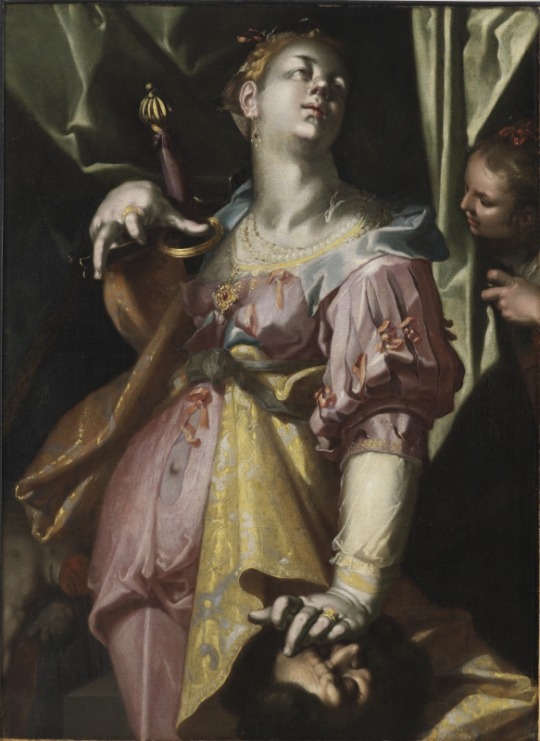
Judith and the Head of Holofernes by Joachim Wtewael, c. 1595–1600
#netherlands#17th c. netherlands#16th c. netherlands#old testament#mdp17th c.#mdp16th c.#Joachim Wtewael#17th century#16th century
159 notes
·
View notes
Text
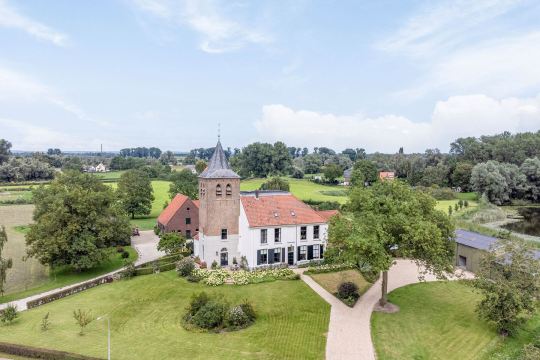
Thanks to Ingek73 for finding this converted 16th cent. church conversion in the Netherlands. It's a 2 unit townhouse with 4bds, 2.5ba, € 1,050,000 kk / $1.125M + € 150/$161 per mo. fee But, the best part is that the half with the bell tower is the one for sale. Plus, it comes with a resident barn owl!
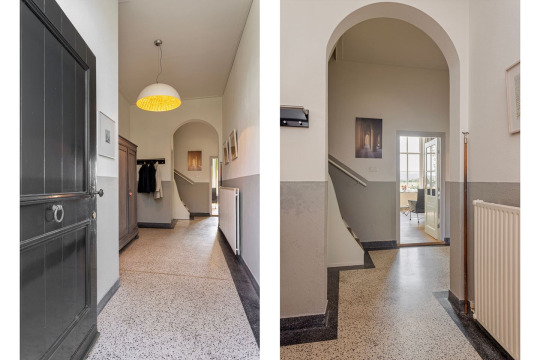
This conversion is a combination of modern and later, plus historic church renos. This is an early c.1950s entrance hall - look at the terrazzo floor and archways. After a period of flooding in the first half of the 19th century, two houses were built in the nave of the church around 1860.


Unlike churches that are basically one huge space, this one is separated into rooms like this sunny open concept living/dining room.

But, look at what they left in this corner- an original ancient wall with remnants of a fresco. This is super cool.

Modern kitchen with what appears to be an original stone floor.

Modern powder room.

Original hallways from the earlier church reno were left intact.

Not sure if this is an office/dining room or an office/conference room, but I love the arched door to the garden.

Arched doors open to this lovely patio.

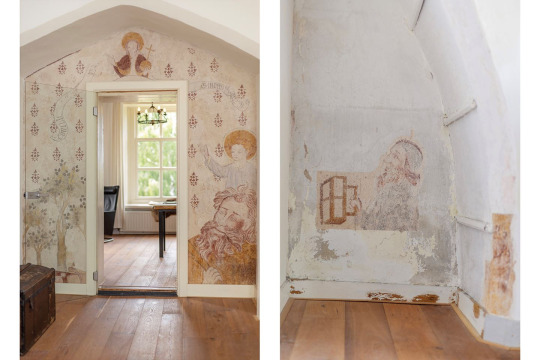
Beautiful details such as wall paintings from the early 16th century that have been professionally preserved and restored.


The original arch above is part of the modern principal bedroom.

Oooh, this would be my personal library.

Very modern baths.
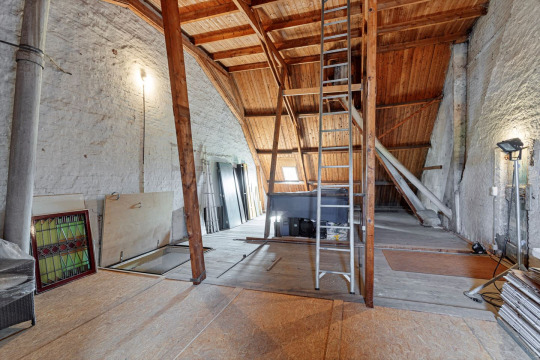
To reach the tower, lift the trap door on the left. And, here we are. Is this getting cool or what?
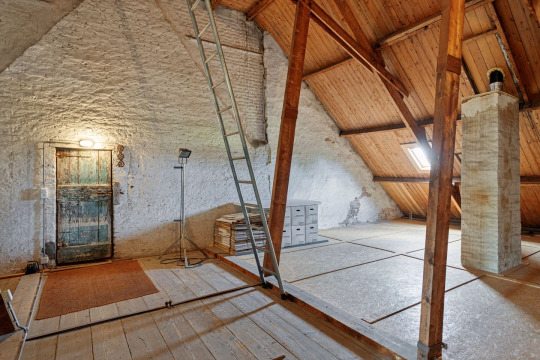
Look at the ancient door.
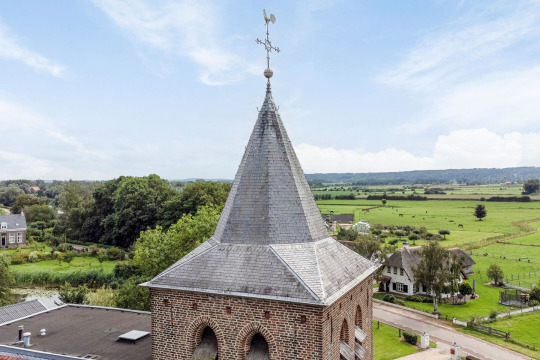
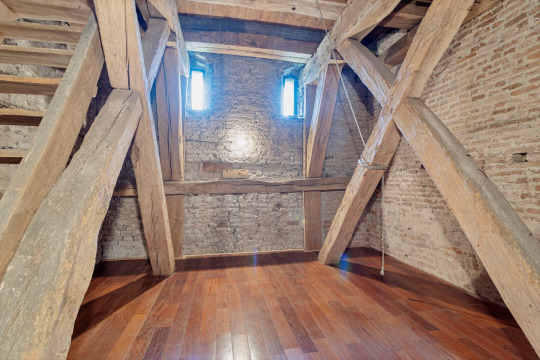
Now, here we are up in the steeple. Note the rope for the bell tied around the beams on the right.
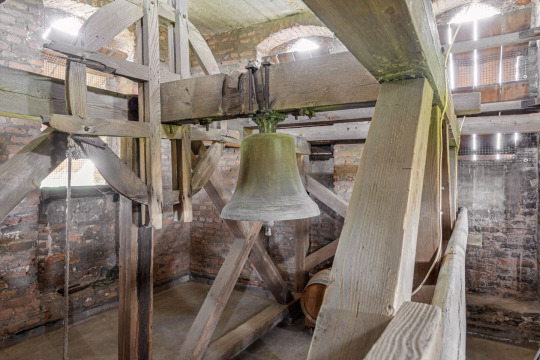
Cool AF.


In the basement I would have to make a rathskeller.
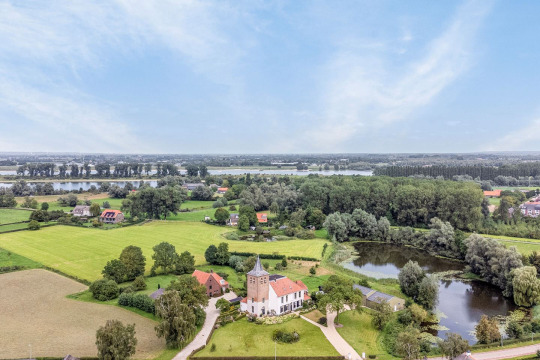
Gorgeous location.
#church conversion#church conversion 16th cen.#church conversion the netherlands#old house dreams#houses#house tours#home tour#submissions
87 notes
·
View notes
Text

Borneo is the largest island in Asia, with a rich history and diverse ethnic groups such as Dayak, Malay, Bajau, Kedayan, Banjar, Kadazandusun and many more.
Borneo, a land blessed with wildlife and unparalleled natural beauty as well as abundant natural resources.
At an estimated 130 million years old, Borneo's rainforest is two times as old as the Amazon rainforest in South America.
Evidence for prehistoric human occupation of Borneo has been found at Neah Cave in Sarawak, including fossil bones, stone tools, and wall and ceiling paintings. Borneo is first mentioned in Ptolemy’s Guide to Geography of about 150 CE. Roman trade beads and Indo-Javanese artifacts have been discovered that give evidence of a flourishing civilization dating to the 2nd or 3rd century CE. Three rough foundation stones with an inscription recording a gift to a Brahman priest dated from the early 5th century, found at Kutai, provide evidence of a Hindu kingdom in eastern Kalimantan. Brahmanic and Buddhist images in the Gupta style have been found in the valleys of the Kapuas and other rivers in western Kalimantan. Later Kalimantan rulers were probably feudatories of the Majapahit empire of eastern Java (c. 1293–1520). With the arrival of Islam early in the 16th century, a number of Muslim kingdoms were founded, including the Banjarmasin, Sambas, Sukadana, and Landak. The Sukadana rulers owed allegiance to the Muslim Mataram kingdom of Java.
Modern European knowledge of Borneo dates from travelers who passed through Southeast Asia in the 14th century. The first recorded European visitor was the Franciscan friar Odoric of Pordenone, who visited Talamasim on his way from India to China in 1330. The Portuguese, followed by the Spanish, established trading relations on the island early in the 16th century. At the beginning of the 17th century the Portuguese and Spanish trade monopoly was broken by the Dutch, who, intervening in the affairs of the Muslim kingdoms, succeeded in replacing Mataram influence with their own. The coastal strip along the South China and Sulu seas was long oriented toward the Philippines to the northeast and was often raided by Sulu pirates. British interests, particularly in the north and west, diminished that of the Dutch. The Brunei sultanate was an Islamic kingdom that at one time had controlled the whole island but by the 19th century ruled only in the north and northwest. In 1841 Sarawak was split away on the southwest, becoming an independent kingdom ruled by the Brooke Raj. North Borneo (later Sabah) to the northeast was obtained by a British company to promote trade and suppress piracy, but it was not demarcated until 1912. Those losses left a much-reduced Brunei, which became a British protectorate in 1888.
During World War II the Japanese invasions of Borneo (1941–42) quickly eliminated the token British and Dutch forces on the island, which was not retaken until 1945. In July 1946 both Sarawak and North Borneo were made British crown colonies. In Dutch Borneo a strong nationalist sentiment developed and led to fighting between Indonesian and Dutch forces as the latter attempted to reimpose Netherlands control. Sovereignty passed to the Indonesians in 1949, and in 1950 a new constitution proclaimed Dutch Borneo part of the Republic of Indonesia.
The British government relinquished its sovereignty over Sabah and Sarawak in 1963, when those territories joined the Malaysian federation. That marked the commencement of Indonesian hostilities in the form of guerrilla raids across the border. Those raids ceased by agreement in 1966. Except for the period of Japanese occupation, Brunei remained a British protectorate until 1983. It became fully independent on January 1, 1984.
BORNEO, 1 Island, 3 Countries
7 notes
·
View notes
Text
More mystery with portraits of Hasburgs
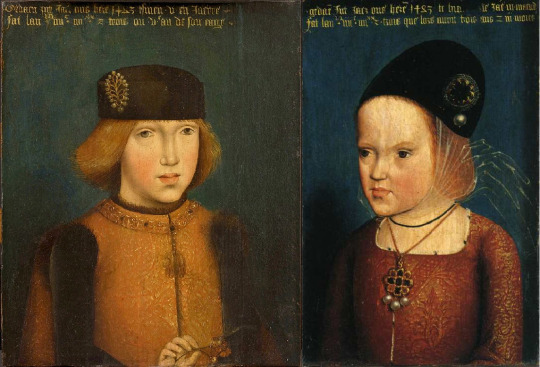
These two paintings are located in different museums, but are believed to be once a part. Currently they are labelled currently as Philip of Austria and Margaret of Austria, 1483, by Master of Legend of Magdalene.
And it's kind of a problem. Because at least the boy doesn't look like early work of this artist at all! Not even remotely close.
So other artists have been suggested instead, and for example the girl's has been most recently labelled as by Pierre Coustain.
Which doesn't make any sense either. Because while this was court artist in Burgundy, he specialized in making coat of arms and flags, sculptures etc. Like we can speculate on Pierre Coustain's involvement in these portraits(figures by Pieter van Coninxloo):

But only about the coats of arms. This guy wasn't portraitist.
...And you know me, I am nitpicker. I my motto is:
Never trust period label...because often times they are added centuries later.
So of course I checked the labels. On first glance, they seem as very genuine. This form of letters was around in 15 and 16th century.
...So I needed some help reading it, but luckily on wikipedia it was in description of paintings.
Girl's:

Gedaen Int Jaer ons here 1483 tsinen v en Jaerre/FAT LAN M.IIII.C.IIII.XX ET TROIS QUE LORS AUOIT TROIS ANS ET TROIS MOIS)
This was created in 1483 and she is 3 years and 3 months old.
(Very specific...oddly so.)

Gedaen Int Jaer ons here 1483 tsinen v en Jaerre / Fat Lan m. III c. IIII xx. z trois ou ve. an de son eage.
Once again it says year 1483, but that Philip is 3 or 5 years old.
Like how does nobody question this? You cannot be specific to month with girl, and not know how old the boy was!
Unless the label is not original at all! And likely not even done in 15th century. Because at those days, labels weren't really popular. They took off mainly in 16th century. And given the amount of mistakes I doubt Margaret nor Philip were even alive when this occured.
Because have they been, somebody would take greater care in getting it correct!
(And, If the text is from much later it is damn well-made.)
So if text is untrust-worthy, the dating of 1483 is also untrust-worthy, and then we cannot even be sure it is Philip or Margaret!

And though the boy doesn't fit Master of Legend's early work, he damn sure looks very alike to his late work! (1510-1527)
But then these kids cannot be royals from Netherlands. This is not its fashion from 16th century. We have portraits of Philip's kids raised in Netherlands, we know what they wore.
And while, yes the girl's hat looks bit like 1460-1470s male hats worn in netherlands, girls didn't wore this I checked. And given Netherlands were already back then northern capital of painters. It's very unlikely it wouldn't appear in art of that time from that country.
So possibly these are foreign royalty. But whom?
Well, artist started working around 1480/1490 and stopped about 1527. (Assuming we have correct artist.)
And the boy wears order of golden fleece around his neck. And clearly he is not adult. List of knights of Order of Golden fleece is on wikipedia and it includes when people got it and their birth year.
So finding people who got it before age of 15 in corrrect timeframe wasn't that hard.
Six candidates:
Philip of Austria (who it is currently identified as)
Henry VIII
Charles V
Ferdinand I, Holy Roman Emperor
Louis II, King of Bohemia and Hungary
Philibert of Chalon
But at age of 14 and 13, Henry VIII and Philibert are simply too old...to be depicted here. And Louis II's sister was older than he. And we know what Charles and his sisters raised in Netherlands wore.
Thus if not Philip and Margaret, the only other valiable option is Ferdinand and Catherine of Austria.
(if the list of candidates was complete...)
And it just so happens that if you put correct dimensions to these(in cm), and put them in order of birth, they don't look so weird...

Potentially this might have once been full set of siblings.
Done firstly around 1507(first four)
and rest after 1515, when Ferdinand became the member of the order.
...And if we compare what the girl wears with spanish fashion, then at least in examples from 1490s similiar hats were popular(not as much raised, but we always see them on adults. Maybe then the raise is not so high, and traluscent veils of this kind even much later(those are with cofia de tranzado)...this shape of neckline, also very popular in Spain at least around turn of the century.

In my research into iberian fashion, i didn't go that much into fashion after 1505(not in debt) and it's not ideal that I point to examples about 20 years prior to when I think it might be.
But it is a possibility, and would explain the resemblence.
...
However then we have to assume 2 more possibilities.
A) the list of knights of order of fleece was not complete...and we're missing candidates...and then once again, where does the fashion point us?...Spain in case of girl...
B) But what if the boy and girl don't belong together?
What if they just had same background(popular in Burgundian/Netherlandish court from 1450? to about 1507)
and same dimensions(by chance, or they were later cut to make them same dimensions)?
(C)what if both options? L)ist wasn't complete and boy and girl don't belong together?
Well, the boys who got orders of golden fleeces as kids were usually royalty, with whom Hasburgs had friendly relationship.
Only other option already not covered, would be either Christian II of Denmark-but he was made member in 1519-so he is on the list, as adult...
or John, Prince of Asturias and Girona. He married Margaret of Austria, in 1497 and died that same year. And Joanna married Philip of Austria in 1496.
We know Margaret's portraits were created in early to mid 1490s, likely to be sent to Spain, and probably Philip's also.
But what if Spanish send reply? And Hasburgs send their own painter, to paint Spanish royal children? That would also explain resemblence to Joanna's children. Because boy would have to be her brother, and girl Joanna herself.
Again, the boy seems to be later work of the master, but it was a workshop. It is possible one of its member simply became more prominent later in workshop's lifetime and it happened to be him who was sent to paint the boy.
And i cannot get further than this. Dendrology would be helpful here.
However as these portraits have year upon them, the institutions who own them think they have the correct date already. We can only hope they decide to test it anyway.
13 notes
·
View notes
Note
I thought that tulips came from Holland. Actually, Tulips are native to Central Asia and Turkey. In the 16th Century they were brought to Holland from Turkey, and quickly became widely popular. It’s so crazy that history can teach you so many things, tulips are my favorite flowers by far
Oh, tulips are my faves, too!
Yes, the tulip is an "exotic", which is why they became so fashionable in the 17th century, especially in The Netherlands. It became a symbol of the trading power and riches of the nation in that period.
Tulips are all over Ottoman period art (began 13th century). You can see them in manuscript illustrations and all over ceramics. The ceramics from Iznik are amazing.
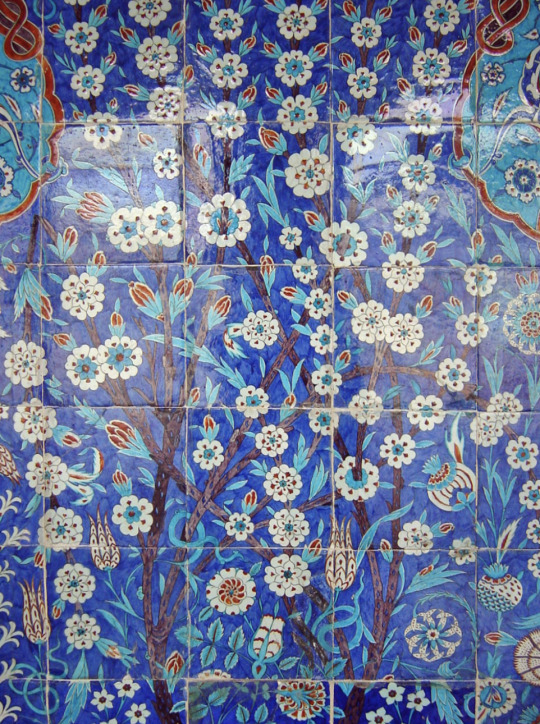
A tile panel in the Rüstem Pasha Mosque in Istanbul, c. 1561. You can see the tulips mixed in with other flowers.
18 notes
·
View notes
Photo
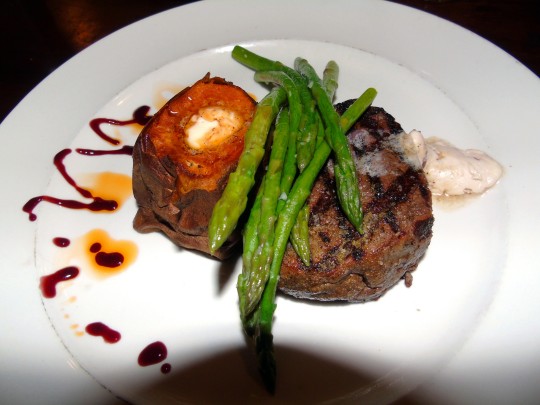
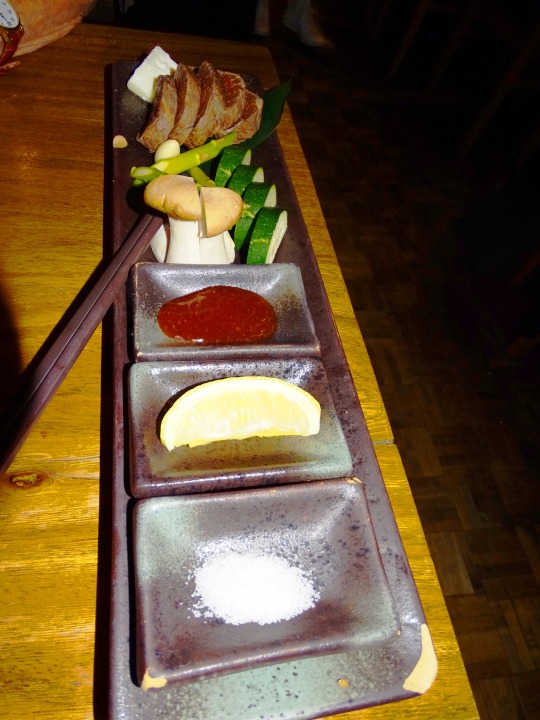



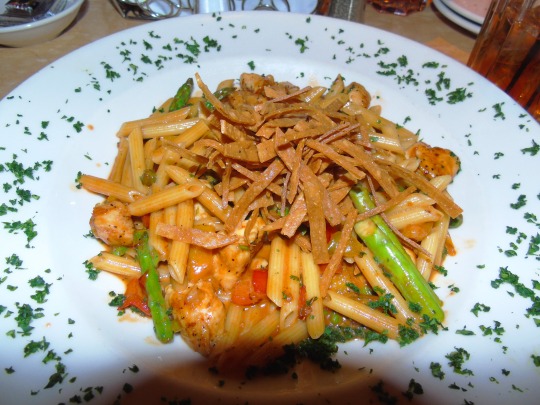
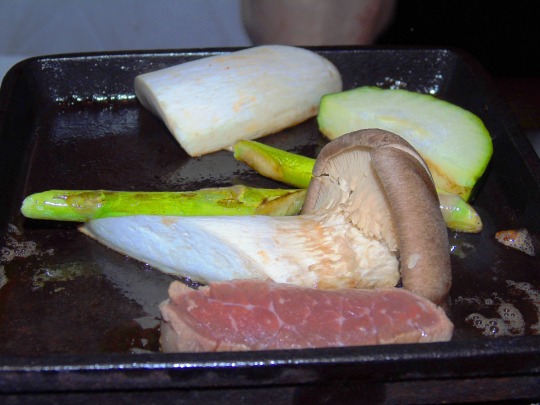



National Asparagus Day
National Asparagus Day is celebrated on May 24, and we are ready to eat! Asparagus production in the United States is concentrated between three states: California, Michigan, and Washington, and it is best in the spring, making it the perfect cookout veggie. This versatile vegetable can be pan-seared, fried, baked, or grilled, and it is full of nutrients like fiber, folate, and vitamins A, C, and E.
History of National Asparagus Day
Asparagus was an ancient vegetable. The ancient Greeks and Romans used it as offerings dating back to 3000 BC. They used the Persian word ‘asparag,’ which meant a shoot or sprout. The term ‘sperage’ became popular for many years and, in the 16th century, we find the term ‘sparagus’ used in English-speaking countries. Peasants called it ‘sparrow grass.’
Asparagus was brought to North America by European settlers as early as 1655. A Dutch immigrant to New Netherland, Adriaen van der Donck, refers to asparagus in his description of Dutch farming practices in the New World. This vegetable was also grown by British immigrants. In 1685, an advertisement for Pennsylvania by William Penn displaying a list of crops that grew well in the American climate included asparagus.
Currently, asparagus production in the United States is mainly in three states: California, Michigan, and Washington. In 2019, the national average asparagus yield was around 4,076 pounds per acre and the total asparagus production was 84.39 million pounds.
Asparagus can take three years to go from seed to harvest, but the plants will produce spears for decades, making it a great crop. However, it is quite labor-intensive, as farmworkers handpick each spear. They carefully excavate around each spear to a depth of nine inches and clip it at the base. That’s a lot of work!
Once seen as an offering for the gods, asparagus continues to be celebrated today. In 2019, Oceana County, Michigan celebrated its 46th National Asparagus Festival. Asparagus is kind of a big deal.
National Asparagus Day timeline
1000 A.D.Asparagus Gets its Name
The Greek word ‘asparagos’ first appears in print in English.
1655Asparagus is Brought to America
Asparagus is brought to North America by European settlers.
1973First National Asparagus Festival
Hart, Michigan holds its first annual National Asparagus Day.
1985National Asparagus Month Begins
Asparagus receives a whole month dedicated to it.
National Asparagus Day FAQs
Fresh or frozen?
Fresh asparagus is great but fresh vegetables can lose nutrients quickly if not used immediately. When frozen, the nutrients are locked in. Either way, asparagus is full of nutrients and is a healthy option.
When did National Asparagus Day begin?
National Asparagus Day is a part of National Asparagus Month, which dates back to 1985.
Can you plant asparagus at home?
Yes, you can. Asparagus should be placed in full sun and lighter soil. Water regularly for the first two years then reduce watering. You can start from one-year-old crowns to get a year’s head start on seeds.
National Asparagus Day Activities
Attend a festival
Visit a farm
Try a new recipe
Share your love for asparagus with like-minded individuals at a festival. You can try Hart, Michigan, or travel to the United Kingdom.
Get your hands dirty and get some extremely fresh asparagus by visiting a farm. There are U-Pick farms located across the United States.
Eating is always a great way to celebrate, so why not try a brand new recipe. You can bake a cheesy sheet pan asparagus or throw it in a frittata; whatever your heart desires.
5 Facts About Asparagus That Will Blow Your Mind
It was used as an offering
It requires patience
Salt was the original herbicide
It’s a hangover cure
Asparagus has its own museum
The ancient Greeks and Romans used it as an offering to the gods.
It takes three years from seed to sow.
Modern farmers often rely on chemical herbicides to manage weed growth, but rock salt was the ancient alternative.
The minerals and amino acids it contains protect the liver from toxins, and the enzymes help break down the alcohol and alleviate hangovers.
You’ll find everything and anything you ever wanted to know about asparagus at the European Asparagus Museum in Bavaria, Germany.
Why We Love National Asparagus Day
Asparagus is versatile
Asparagus is nutritious
Asparagus burns fat
What can you do with spinach? Sauté it? Throw it in a salad? What can you do with asparagus? Air fry it, bake it, grill it, add it to eggs, throw it in a salad, and more. That deserves a celebration.
Asparagus not only provides fiber and folate, but it is also rich in saponins, which are a type of phytonutrient credited with reducing cancer risks and assisting in maintaining blood pressure, regulating blood sugar, and controlling blood lipid levels.
Asparagus contains the chemical asparagine, an alkaloid that has a direct effect on our body’s cells and helps break down fat. Asparagus is also composed of a chemical that assists in removing waste from the body, which reduces fat levels.
Source
#Salmon & shrimps Smörrebröd#Spicy Chicken Chipotle Pasta#Sweden#USA#Canada#food#restaurant#Jaja Beef#Blacked Creole Chicken#Buffalo Tenderloin#aspargussalad#Maze by Gordon Ramsey#egg#mushroom#original photography#travel#vacation#National Asparagus Day#24 May#AsparagusDay#close up
3 notes
·
View notes
Text
The Ultimate Guide to Growing Tomatoes in Europe: Climate, Soil, and Indoor Seed Care
Tomatoes are one of the most popular vegetables grown across Europe. Originally from South America, tomatoes were brought to Europe in the 16th century by European explorers. However, it took some time for Europeans to warm up to the fruit. Initially, tomatoes were primarily grown for their ornamental value in gardens rather than for consumption. Over the centuries, Europe’s Tomato Seed gained popularity as a food crop across Europe. Nowadays, countries like Italy, Spain, France and the Netherlands are major producers and consumers of tomatoes in the European region. Climate and Soil Requirements for Europe’s Tomato Seed For successful tomato cultivation, it is important to understand the climate and soil requirements. Tomatoes grow best in warm temperatures between 18-30°C. Most parts of Europe experience suitable warm summer months for tomatoes to mature. However, northern regions may require protection from early or late frosts. Tomatoes also need at least 6 hours of direct sunlight per day for optimal growth. In terms of soil, tomatoes prefer loose, well-draining soil rich in organic matter. Heavy clay or soggy soils prone to waterlogging should be avoided. The ideal soil pH range is between 6-7. Soil enrichment with compost or well-rotted manure before planting helps boost fertility. Growing Tomato Seeds Indoors In colder parts of Europe, Europe Tomato Seeds common to start tomato seeds indoors 6-8 weeks before the last expected spring frost. This allows seedlings to develop into strong transplants ready to be planted outdoors once temperatures warm up. Sow seeds in seed starter mix in small pots or cell packs. Maintain a temperature of 18-24°C and provide bottom heat if possible. Make sure the soil remains moist but not soggy. Seedlings usually emerge within 7-14 days. Provide adequate sunlight, such as under grow lights. Harden off seedlings before transplanting outside for at least a week. Transplanting and Planting Outdoors When night temperatures remain above 10°C, tomato seedlings can safely be transplanted outdoors. Prepare the planting area by clearing weeds and loosening the top 15cm of soil. Space transplanting 60-90cm apart depending on the variety. Dig holes twice the width and depth of each seedling’s container. Gently remove seedlings by squeezing the sides of the container. Plant at the same soil level the seedling was growing in indoors. Water thoroughly after transplanting and apply a 2-4cm thick layer of mulch around the base of each plant to help retain moisture. Stake or cage tomatoes for support as they grow. Varieties of Tomatoes Grown in Europe Over time, many tomato varieties have been specially bred to thrive under Europe’s Tomato Seed growing conditions. Some commonly grown varieties include: - Cherry/Grape Tomatoes: Ideal for containers or short seasons. Varieties include 'Sugar Lump', 'Tommy Toe' and 'Sweet 100'. - Plum Tomatoes: Excellent for sauces and canning. Try 'Romantica', 'San Marzano' and 'Gianni'. - Beefsteak Tomatoes: Large slicing tomatoes great for meals. Favorites are 'Ace 55', 'Super Steak' and 'Brandywine'. - Heirloom Tomatoes: Unique flavors and history. Popular kinds are 'Green Zebra', 'Black Krim' and 'Cherokee Purple'. - Cherry on the Vine Tomatoes: Long clusters of cherry tomatoes remain attached to the vine for easy picking. 'Sungold' is a top choice. Common Pests and Diseases of Tomatoes in Europe Unfortunately, tomatoes do face some pest and disease issues in European gardens that growers need to watch out for: - Tomato Hornworms: Large green caterpillars defoliate plants. Handpick and destroy.
Get more insights on Europe Tomato Seeds
For Deeper Insights, Find the Report in the Language that You want.
French
German
Italian
Russian
Japanese
Chinese
Korean
Portuguese
Priya Pandey is a dynamic and passionate editor with over three years of expertise in content editing and proofreading. Holding a bachelor's degree in biotechnology, Priya has a knack for making the content engaging. Her diverse portfolio includes editing documents across different industries, including food and beverages, information and technology, healthcare, chemical and materials, etc. Priya's meticulous attention to detail and commitment to excellence make her an invaluable asset in the world of content creation and refinement.
(LinkedIn- https://www.linkedin.com/in/priya-pandey-8417a8173/)

#Europe Tomato Seeds#Heirloom Tomato Seeds#Organic Tomato Seeds#Gardening#Agriculture#Farming#Vegetables#Seeds#Gardening Supplies#Plant Seeds
1 note
·
View note
Text




a quick note! these are not medieval paintings!
almost every time i see these works online, they are dated c. 1500 - 1800. they are always posted without any artist credit, and if they are attributed to someone, it is usually an incorrect attribution to medieval artist joos van cleve. these works were actually created by artist josé van kleef. (not sure where else to put this, but in the netherlands, josé is a woman's name. josé van kleef is a woman. this is a mistake i also see a lot.)
the confusion here is understandable, but this does in fact speak to a much larger issue, which is improperly credited or totally uncredited cat art. i have found very quickly through this hobby that, for whatever reason, paintings of funny looking cats throughout history are regularly mislabelled as belonging to the wrong artists and/or the wrong periods. part of this is pretty clearly because of the "medieval cat art" meme. works like these which are slightly surrealist and painted with oils are all over sites like facebook, pinterest and weheartit with tags like "funny medieval cat" and "16th century art".
in fact, in trying to identify these paintings, i was only able to find legitimate information on one of them. the third image in this set is called "cat on a treestump", and it was painted in 1956.
i'm not sure what my goal is with making this post, other than to say this; next time you see this funny looking cats, please remember josé van kleef!
0 notes
Text

Unknown (Netherlands, 16th c.)
The Laughing Fool
Nationalmuseet, Stockholm
1 note
·
View note
Photo

Portait of a lady and a young girl by Adriaen van Cronenburg, 1567
132 notes
·
View notes
Text
Daily Current affairs of 1st Feb 2023

Practice daily Current affairs and give quiz for assess your knowledge. Today you can study current affairs of 1st Feb 2023 and this is suitable for almost all type of government competitive exams.
Daily Current affairs for 1st Feb 2023
1. What is the name of India's first space mission designed to examine the Sun? A. Aditya-L1 B. Surya-L1 C. Rakshak-L1 D. Samyukth-L1 Answer Aditya-L1 2. Which state announced to give allowance (monthly basis) to unemployed youth from next financial year? A. Gujarat B. Assam C. Chhattisgarh D. Rajasthan Answer Chhattisgarh 3. Which city is the host of ‘National Child Science Congress’ in 2023? A. Ahmedabad B. Mysuru C. Pune D. Kolkata Answer Ahmedabad 4. Which state is undertaking the Caste-Based Survey (CBS) in India? A. Jharkhand B. Madhya Pradesh C. Bihar D. Arunachal Pradesh Answer Bihar 5. US-based Hindenburg Research published a report accusing which business group for stock manipulation? A. Reliance Industries B. Adani Group C. ITC Limited D. Aditya Birla Group Answer Adani Group 6. Which of the following has been named Country Partner for BioAsia 2023? A. Russia B. United Kingdom C. Egypt D. USA Answer United Kingdom 7. Lisa Loring passed away on 30 January 2023. She was a famous______. A. Actress B. Lawyer C. Doctor D. Cricketer Answer Actress 8. President Droupadi Murmu will address the 31st Foundation Day of the National Commission for Women (NCW) in New Delhi. When is the Foundation Day of NCW celebrated? A. 31 January B. 1 February C. 2 February D. 3 February Answer 31 January 9. Who has been appointed as the first Chief Executive Officer (CEO) of the Gujarat Maritime Cluster in January 2023? A. Naresh Lalwani B. Bharat Bhasker C. Madhvendra Singh D. Siddharth Sement Ahmeharma Answer Madhvendra Singh 10. Which country won the FIH Men’s Hockey World Cup 2023 title? A. Belgium B. Germany C. Netherlands D. Poland Answer Germany Now Try Quiz of Feb Current Affairs 2023 Attention: You must prepare daily current affairs of Feb 2023 for Quiz, so you can rank better and motivate for your upcoming government exam competition.
Also practice other's day current affairs of Feb 2023
- Current affairs of 1st Feb 2023 - Current affairs of 2nd Feb 2023 - Current affairs of 3rd Feb 2023 - Current affairs of 4th Feb 2023 - Current affairs of 5th Feb 2023 - Current affairs of 6th Feb 2023 - Current affairs of 7th Feb 2023 - Current affairs of 8th Feb 2023 - Current affairs of 9th Feb 2023 - Current affairs of 10th Feb 2023 - Current affairs of 11th Feb 2023 - Current affairs of 12th Feb 2023 - Current affairs of 13th Feb 2023 - Current affairs of 14th Feb 2023 - Current affairs of 15th Feb 2023 - Current affairs of 16th Feb 2023 - Current affairs of 17th Feb 2023 - Current affairs of 18th Feb 2023 - Current affairs of 19th Feb 2023 - Current affairs of 20th Feb 2023 - Current affairs of 21st Feb 2023 - Current affairs of 22nd Feb 2023 - Current affairs of 23rd Feb 2023 - Current affairs of 24th Feb 2023 - Current affairs of 25th Feb 2023 - Current affairs of 26th Feb 2023 - Current affairs of 27th Feb 2023 - Current affairs of 28th Feb 2023 Read the full article
0 notes
Note
Hope this works : https://i.pinimg.com/564x/40/e6/eb/40e6eb52d24dee59e597ca00f46bcddd.jpg
Original ask:People keep saying this is Frances Brandon, but looking at the fashion and the features of the sitter, I feel it's Katherine of Aragon instead. What are your thoughts?
(we didnt have the photo originally, but now i can finally answer this).
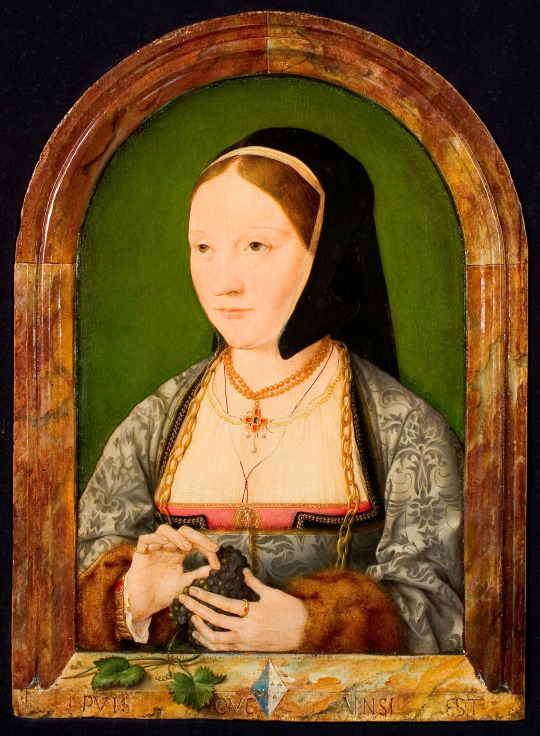
-My first observation regarding this painting is that it cannot be Francis Brandon, because she was born in 1517. This is 1500s or 1510s fashion of Netherlands. No way she could be depicted in fashion which is from before she was even born!
On wikipedia it is labelled Portrait of Agniete van den Rijne, atributed to Joos van Cleve, located in Rijksmuseum Twenthe in Enschede, in Netherlands. And as being painted in 1st half of 16th century.
On webpage of the museum, it is labelled as Unknown woman in c.1515. I suspect it could be bit earlier(split gown, large hanging chains)-my guess would be late 1500s, max early 1510s. But my chronology of netherlandish fashion was based upon court fashion. And neckline this low is consistent with some parts of Habsburg Netherlands, but not the court. So I could be bit off. But either way-1500s or 1510s imo. Not Francis Brandon. She wasnt even born when this was in fashion.
As for Catherine of Aragon.
Not that she couldnt wear netherlandish fashion(Sittow's portrait)-but a)when she did wear it, it was same fashion as in court.
b) what cut photos deliberately left out, is that this painting has its original frame...which includes coat of arms.

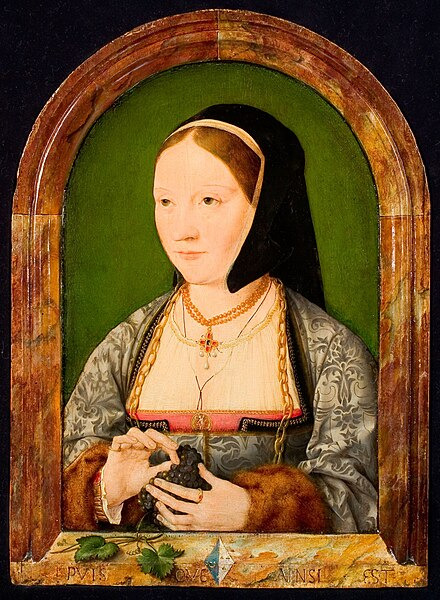
And experts believe this coat of arms to be original.

They havent been able to identify it nor of the man matching the woman. But clearly not Catherine's coat of arms.
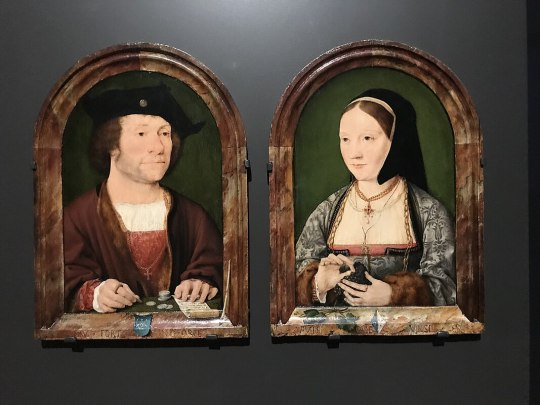
Also the focus here is on grapes-its fruit, its leaves and vines.
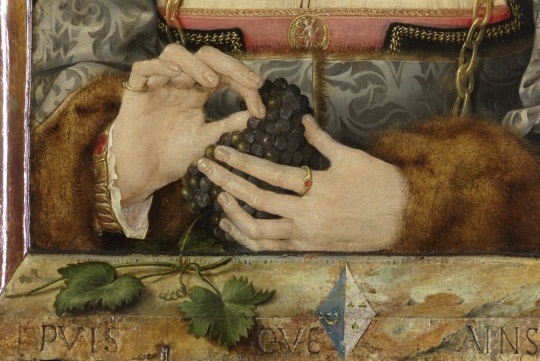
It is symbol of fertility and prosperity, as well as having several more meanings in christianity, but as far as i know never asociated with Catherine of Aragon specifically. And there is literally nothing to suggest it is her.
I agree that there is resemblence, but there is issue. The artist was skilled. So why upon closer inspection the nose looks so differently than hers?
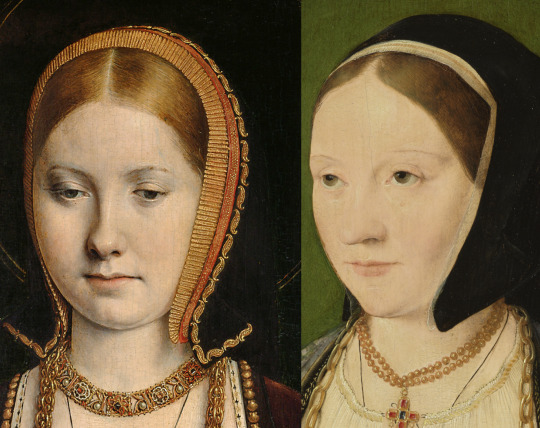
Catherine's nose tip seemed to be pointing more up and it was not as large. With some people-for example Margaret of Austria, size of nose changes as they age(due to health issues). However Catherine even in mid 1520s, still has narrow nose with tip basically same as in her youth.

Angle might play part a bit...but imo it is simply different nose.
The resemblence alone cannot drive identification. Not only do we not have single major clue pointing towards Catherine, we have major clue against her(coat of arms). Also Henry was likely painted by the artist when he met Francis I at Calais-with Anne Boleyn. The artist was asociated a lot with Francis, but never proven to travel to England or to take comissions from English royal court...aside that one meeting.
I am sorry, it is not Catherine of Aragon.
I am as upset as you guys that we don't have any surviving portrait of her from 1510s, and that many portraits we only know from not so great copies.
To find more lost originals, looking through art of artists which painted relatives of the person is indeed very good strategy. It pays off in many cases. Unfortuntely not in case of Joos van Cleve.
But it might be good idea to look up painters employed by Charles V and by Francis I in 1520-because Catherine met both that year.
Henry and Charles even had joined portraits made back then.
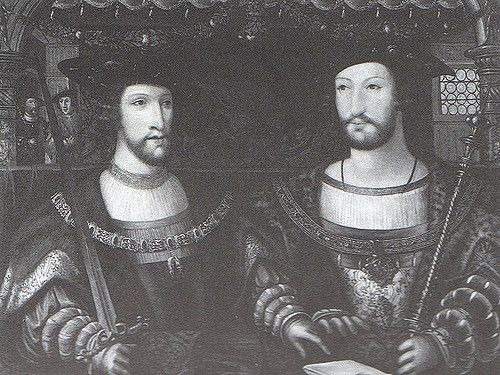
So there is indeed potential that some portrait of Catherine was created and it might have went with visitor. And it could have been another joined portrait because Charles didnt visit alone but with Germaine of Foix.
Problem is, the most likely thing for Catherine to wear in any portrait as Queen of England is gable hood- headwear unique to England. For her portraits to not be noticed, they would either have to be overpainted/altered, misidentified, misdated or even all three.
Another option is that upon meeting Charles that she wore spanish fashion. If she got painted in that, she wouldnt be that likely to be recognized.
Or maybe we need to broaden our idea of what Catherine wore.
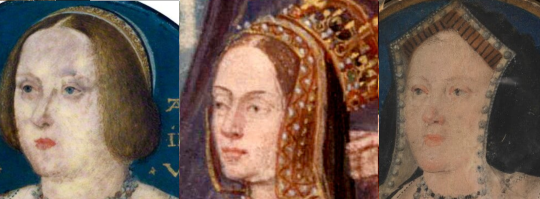
So my dears, the hunt is still on.
6 notes
·
View notes
Text
Medieval Scotland itself may have been an out of the way place, but anyone who thinks that medieval Scots were cut off from wider trends, particularly on the European continent, really has not understood the character of Scots across the centuries at all
#We never shut up about Scotland for a start but we also tend to leave it in HUGE numbers#And this was no different for the Middle Ages though the mass emigration of the modern period hadn't yet started#Students were frequently abroad even after we got three universities of our own- that was the thing you got educated abroad#Merchant colonies can be found from Poland to the Mediterranean though the Netherlands are particularly well represented#Not to mention military links- Scots were frequently found fighting other countries' wars and nowhere more so than France#the Garde Ecossaise is famous enough I should think!#Not to mention our historically important links across the North Sea with Norway and Denmark though the strength ofthis fluctuated over time#There are cadet branches of Scottish families in France; there's a legend of a 'lost clan' in an Italian valley;#once when I was on holiday in the Netherlands and we were going round a Gelderland castle the guide heard we were Scots#And happened to say 'huh that's cool because there's a lot of people round here with a Scottish surname'- a Dutch version of Armstrong#There were Scots on crusade obviously but there were also Scots working in southern Spain and other areas of Muslim influence#Not to mention the other way round! ESPECIALLY in the twelfth and thirteenth centuries Scotland saw huge immigration into it#Whether Norse or Norman or Flemish and they mixed with the resident Gaelic and British and Anglo-Saxon cultures forming a hybrid nation#And we can trace the DOCUMENTS of Roma and 'Moor' (a wide range of peoples fit this medieval descriptor) back to the late 15th/early 16th c.#if not earlier#I've really not explained this very well at all but like key to understanding medieval Scotland is its links with the outside world#Although a country on the edge geographically but its people- at least in the upper echelons of society though probably lower too-#were as a group almost always trying to be outward-looking and trying to stay ahead of the curve#They didn't always succeed whether due to lack of funds or lack of internal political stability or a small population#But it was key to medieval Scotland's character that the Scots were always trying to push themselves into the European centre#And that not just politically but- perhaps more importantly and long-lasting- in terms of education and trade and culture#Ok I've ranted long enough and haven't explained it properly but essentially if you're going into medieval Scotland#expecting to find a cultural backwater cut off from the rest of Europe then you've fundamentally misunderstood the Scots#And their ability to shove their way into literally everything#This goes also for the British Empire but that's not quite such a proud legacy for Scotland cos we suck and all but that's another story
102 notes
·
View notes
Text



















National Asparagus Day
National Asparagus Day is celebrated on May 24, and we are ready to eat! Asparagus production in the United States is concentrated between three states: California, Michigan, and Washington, and it is best in the spring, making it the perfect cookout veggie. This versatile vegetable can be pan-seared, fried, baked, or grilled, and it is full of nutrients like fiber, folate, and vitamins A, C, and E.
History of National Asparagus Day
Asparagus was an ancient vegetable. The ancient Greeks and Romans used it as offerings dating back to 3000 BC. They used the Persian word ‘asparag,’ which meant a shoot or sprout. The term ‘sperage’ became popular for many years and, in the 16th century, we find the term ‘sparagus’ used in English-speaking countries. Peasants called it ‘sparrow grass.’
Asparagus was brought to North America by European settlers as early as 1655. A Dutch immigrant to New Netherland, Adriaen van der Donck, refers to asparagus in his description of Dutch farming practices in the New World. This vegetable was also grown by British immigrants. In 1685, an advertisement for Pennsylvania by William Penn displaying a list of crops that grew well in the American climate included asparagus.
Currently, asparagus production in the United States is mainly in three states: California, Michigan, and Washington. In 2019, the national average asparagus yield was around 4,076 pounds per acre and the total asparagus production was 84.39 million pounds.
Asparagus can take three years to go from seed to harvest, but the plants will produce spears for decades, making it a great crop. However, it is quite labor-intensive, as farmworkers handpick each spear. They carefully excavate around each spear to a depth of nine inches and clip it at the base. That’s a lot of work!
Once seen as an offering for the gods, asparagus continues to be celebrated today. In 2019, Oceana County, Michigan celebrated its 46th National Asparagus Festival. Asparagus is kind of a big deal.
National Asparagus Day timeline
1000 A.D.Asparagus Gets its Name
The Greek word ‘asparagos’ first appears in print in English.
1655Asparagus is Brought to America
Asparagus is brought to North America by European settlers.
1973First National Asparagus Festival
Hart, Michigan holds its first annual National Asparagus Day.
1985National Asparagus Month Begins
Asparagus receives a whole month dedicated to it.
National Asparagus Day FAQs
Fresh or frozen?
Fresh asparagus is great but fresh vegetables can lose nutrients quickly if not used immediately. When frozen, the nutrients are locked in. Either way, asparagus is full of nutrients and is a healthy option.
When did National Asparagus Day begin?
National Asparagus Day is a part of National Asparagus Month, which dates back to 1985.
Can you plant asparagus at home?
Yes, you can. Asparagus should be placed in full sun and lighter soil. Water regularly for the first two years then reduce watering. You can start from one-year-old crowns to get a year’s head start on seeds.
National Asparagus Day Activities
Attend a festival
Visit a farm
Try a new recipe
Share your love for asparagus with like-minded individuals at a festival. You can try Hart, Michigan, or travel to the United Kingdom.
Get your hands dirty and get some extremely fresh asparagus by visiting a farm. There are U-Pick farms located across the United States.
Eating is always a great way to celebrate, so why not try a brand new recipe. You can bake a cheesy sheet pan asparagus or throw it in a frittata; whatever your heart desires.
5 Facts About Asparagus That Will Blow Your Mind
It was used as an offering
It requires patience
Salt was the original herbicide
It’s a hangover cure
Asparagus has its own museum
The ancient Greeks and Romans used it as an offering to the gods.
It takes three years from seed to sow.
Modern farmers often rely on chemical herbicides to manage weed growth, but rock salt was the ancient alternative.
The minerals and amino acids it contains protect the liver from toxins, and the enzymes help break down the alcohol and alleviate hangovers.
You’ll find everything and anything you ever wanted to know about asparagus at the European Asparagus Museum in Bavaria, Germany.
Why We Love National Asparagus Day
Asparagus is versatile
Asparagus is nutritious
Asparagus burns fat
What can you do with spinach? Sauté it? Throw it in a salad? What can you do with asparagus? Air fry it, bake it, grill it, add it to eggs, throw it in a salad, and more. That deserves a celebration.
Asparagus not only provides fiber and folate, but it is also rich in saponins, which are a type of phytonutrient credited with reducing cancer risks and assisting in maintaining blood pressure, regulating blood sugar, and controlling blood lipid levels.
Asparagus contains the chemical asparagine, an alkaloid that has a direct effect on our body’s cells and helps break down fat. Asparagus is also composed of a chemical that assists in removing waste from the body, which reduces fat levels.
Source
#filet with asparagus mashed potatoes and tomatoes#Salmon & shrimps Smörrebröd#Spicy Chicken Chipotle Pasta#Blacked Creole Chicken#Bison Filet#Asparagus Day#watermelon#egg#swee potato#original photography#food#restaurant#Sweden#Canada#USA#travel#summer vacation#NationalAsparagusDay#National Asparagus Day#vacation#24 May#JaJa Beef#DonDon Izakaya#Salmon & Shrimps Smørrebrød#tourism#national day#close up#asparagus salad
1 note
·
View note
Text
Majolica (maiolica) ware
In different periods of time and in different countries the word majolica has been used for two distinct types of pottery.
Firstly, from mid-15th century onwards there was maiolica, a type of pottery reaching Italy from Spain, Majorca[1] and beyond. This was made by a tin-glaze process (dip, dry, paint, fire), resulting in an opaque white glazed surface decorated with brush-painting in metal oxide enamel colour(s).
During the 17th century, the English added the letter j to their alphabet.[2]Maiolica was commonly anglicized to majolica thereafter.
Secondly, there is the Victorian mid to late 19th century type of pottery also known as majolica made by a more simple process (paint, fire) whereby coloured lead silicate glazes were applied direct to an unfired clay mould, typically relief-moulded, resulting in brightly coloured, hard-wearing, inexpensive wares both useful and decorative, typically in naturalistic style. This type of majolica was introduced to the public at the 1851 Great Exhibition in London, later widely copied and mass-produced. Minton & Co., who developed the coloured lead glazes product, also developed and exhibited at the 1851 Exhibition a tin-glazed product in imitation of Italian maiolica which they called also majolica.
-- Majolica on Wikipedia
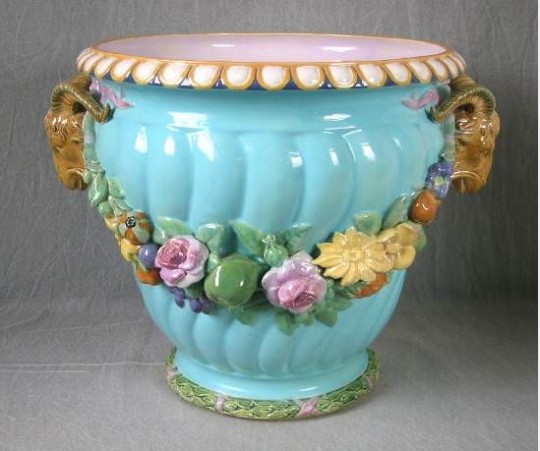
Coloured lead glazes majolica, flowers moulded in high relief. Shape first shown at the 1851 Exhibition by Minton & Co., Exhibit Number 60.
Maiolica /maɪˈɒlɪkə/ is tin-glazed pottery decorated in colours on a white background. Italian maiolica dating from the Renaissance period is the most renowned. When depicting historical and mythical scenes, these works were known as istoriato wares ("painted with stories"). By the late 15th century, multiple locations,[1] mainly in northern and central Italy, were producing sophisticated pieces for a luxury market in Italy and beyond. In France maiolica developed as faience, in the Netherlands and England as delftware, and in Spain as talavera. [...] In the 15th century, the term maiolica referred solely to lustreware, including both Italian-made and Spanish imports, and tin-glaze wares were known as bianchi (white ware).[4] By 1875 the term was in use describing ceramics made in Italy, lustred or not, of tin-glazed earthenware.[5] With the Spanish conquest of Mexico, tin-glazed maiolica wares came to be produced in the Valley of Mexico as early as 1540, at first in imitation of tin-glazed pottery imported from Seville.[6] Mexican maiolica is known famously as 'Talavera'.
"By a convenient extension and limitation the name may be applied to all tin-glazed ware, of whatever nationality, made in the Italian tradition ... the name faïence (or the synonymous English 'delftware') being reserved for the later wares of the 17th Century onwards, either in original styles (as in the case of the French) or, more frequently, in the Dutch-Chinese (Delft) tradition."[7] The term "maiolica" is sometimes applied to modern tin-glazed ware made by studio potters.
-- Maiolica on Wikipedia
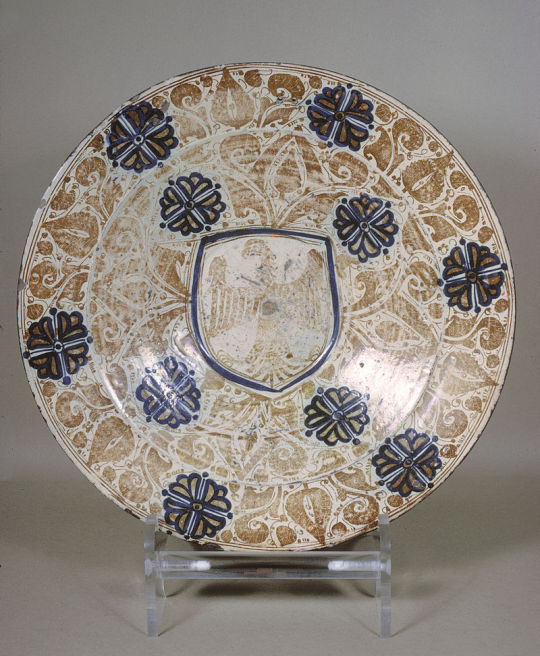
Hispano-Moresque maiolica, c. 1450, tin-glazed with lustre decoration, Moorish Spain.
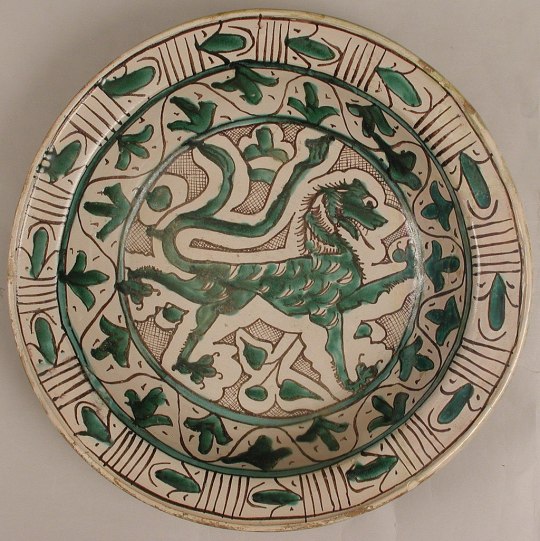
"Earthenware, tin-glaze (Majolica), early 15th century, Italy." Metropolitan Museum NY.
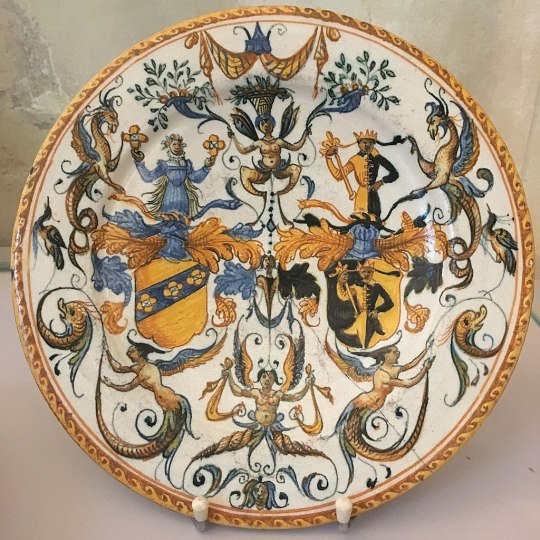
Tin-glazed majolique armoriée, France, late 16th century. Italian Renaissance Grotesque style.
The earlier style of ceramic referred to here as “maiolica ware” according to this distinction is still commonly Anglicized as “majolica” - in English usage they are simply both grouped under the same heading much of the time, although the “maiolica” spelling occasionally occurs. (Observe the previous post, in which Martha Stewart is mostly talking about the molded English-style Majolica, but the header image depicts maiolica ware - probably modern traditional style Italian.) However, I use the terms non-interchangeably on this blog for ease of search and tagging.
#majolica ware#maiolica ware#ceramic#victorian design#english design#french design#spanish design#italian design#renaissance design#faience
49 notes
·
View notes
Photo

Cornelis van Dalem (attr.) and Jan van Wechelen (attr.) - Church interior with Christ preaching to a crowd -
oil on panel, height: 59 cm (23.2 in); width: 93 cm (36.6 in)
Rijksmuseum, amsterdam. the Netherlands
Cornelis van Dalem (1530/35 – 1573 or 1576) was a Flemish painter and draughtsman active in Antwerp in the middle of the 16th century and an important contributor to the development of landscape art in the Low Countries. Van Dalem introduced into landscape painting new themes, which he derived from his humanistic education, and searched for new ways of representing his themes.
Jan van Wechelen or Hans van Wechelen (c. 1530 – 1570) was a Flemish painter and draughtsman active in Antwerp in the middle of the 16th century known for his landscapes, biblical subjects and genre scenes.
A composition entitled Church interior with Christ preaching to a crowd (Rijksmuseum) is attributed to a collaboration between van Wechelen and van Dalem. It shows a large church interior with a crowd of people in contemporary as well as foreign dress who are listening to Jesus Christ who is preaching while seated near a column. The interior of the church is quite barren and the only decorations seen are some sculptures high on the columns. Various scenes are depicted in the interior of the church such as priests chasing away children, a man with a walking stick and a dog who is accosted by a man in thorn clothes (a beggar?), some dogs sniffing each other, a couple flirting, a man with a shovel etc.
Van Dalem, his collaborator on this composition, was suspected of being a Protestant and possibly the composition contains criticism of the Catholic Church. By placing a preaching Jesus amidst modern church architecture and a contemporary crowd the composition should possibly also be read against the background of the iconoclasm of the Beeldenstorm, which had caused a reflection on the role of religious art in the Low Countries. The attack on sculptures and paintings had placed the entire church interior under discussion. Finding answers to questions such as what a church should be, which type of architecture was suitable and how it should be embellished had become urgent. Contemporary religious practice was compared with the words and deeds of Christ and his apostles and the past and the future of religion, its temples and its rites were under scrutiny.
15 notes
·
View notes